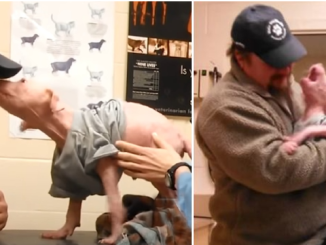
As the availability of COVID-19 tests dwindle across Canada, another option to detect the virus in the form of a furry friend may be the next best thing.
Multiple studies show that dogs can be more effective, faster and potentially less expensive than the current tests on the market.
The research has grown since 2020, with University of California Santa Barbara professor Tommy Dickey finding the collective research shows trained scent dogs are “as effective and often more effective” than both the rapid antigen tests many people keep in their homes, and even the PCR tests deployed at clinics and hospitals.
But even with studies showing their effectiveness, COVID-19-detecting dogs are deployed only in certain jurisdictions in various countries.
One such place is the Canines for Care program at Vancouver Coastal Health (VCH), which started looking into the possibility of training dogs to detect COVID-19 in early 2021.
Dr. Marthe Charles, division head of medical microbiology and infection prevention and control at VCH, said the idea stemmed from the early reliance on laboratory testing.
“I think there was a will from public health at the time and also from the various levels of government to try to find a way that was fast, accurate and non-invasive to be able to detect and train as many people as possible,” Charles told Global News in an interview.
Three dogs — two Labrador retrievers and an English springer spaniel — were brought in for training. The dogs were exposed to items such as masks that were worn by patients either negative or positive for the virus. This trained the dogs to recognize what is and is not COVID-19.

Charles said the dogs were trained since being puppies to associate the scent of COVID-19 with food and were rewarded each time they correctly detected a positive case of the virus.
“So from early on in their lives, they’ve associated the scent of a case of COVID to a rewarding scent,” she explained.
This reward method is not just used by VCM. It was also used with a group of dogs sourced in early 2021 for a French study, trained at detection using toys — usually tennis balls — as rewards.
Dr. Carla Simon, owner of Hunter’s Heart Scent Detection Canines in Calgary, said this method of training dogs is common. By using rewards, it can help motivate them to find the scent.
“We would pair, let’s say, the sweat samples with COVID, with their reward, and they notice that every time they find their reward, there’s that special smell,” she explained. “We just have to make it rewarding for the dog.”
She added, however, that the dog chooses the reward so trainers can ensure the canines “show up every day and want to do their job.”
Earlier this month, Dickey along with Heather Junqueira of BioScent, Inc. gathered several peer-reviewed studies into a review that was published in the Journal of Osteopathic Medicine. Dickey said the number of peer-reviewed studies over the past few years went from four to 29, incorporating the work of more than 400 scientists from more than 30 countries and 31,000 samples.
The review noted the effectiveness of dogs’ ability to detect COVID-19 comes down to their noses.

“The nose is not like humans,” Simon said. “It’s massively different, orders of magnitude different, and they can detect things without us being able to smell them.”
Humans have about five to six million olfactory receptors in their noses, while dogs have hundreds of millions. One-third of their brain is devoted to the interpretation of smell — something only five per cent of a human’s brain is committed to, according to Dickey’s review.
The study found dogs’ noses may even be able to detect pre-symptomatic COVID-19 cases, or even those who will develop symptoms later.
Dickey told us in an interview that this could help limit or stop the virus from spreading.
“The longer the wait is between your test and your result, that’s a latent period,” he said. “During that time you’re running around spreading COVID and you don’t know it. The dogs with a direct sniff will be done in seconds.”
Many of the studies conducted, including the work at VCH through the Canine for Care program, have shown dogs’ ability to detect the disease correctly with a success rate of more than 90 per cent. Additionally, the studies also showed a high speed at which the dogs could identify cases. In one study in Thailand, researchers reported the dogs had gone through thousands of samples in just a few weeks.
“The dogs take only one to two seconds to detect the virus per sample. Once they detect a patient, they will sit down,” said Chulalongkorn University professor Kaywalee Chatdarong, who led the 2021 project. “This takes only one to two seconds. Within one minute, they can manage to go through 60 samples.”
Even though the research suggested deploying scent-detection dogs could also be less expensive than rapid or PCR tests, Charles cautioned the logistics that go into training the dog is where it becomes “more prohibitive.”

In VCH’s case, training of the dogs included the medical microbiology lab to provide samples for use, working with infection prevention teams and control nurses, and if a dog identifies an area of concern, cleaning services may need to be utilized. And when it comes to rolling out testing using the dogs, enough staffing is needed for mass screening.
Despite this, while Charles says deploying the dogs widely could be difficult due to staffing and training, they are still one of several tools that can be used in COVID-19 detection.
“I think the way to see those dogs from my perspective is really like another tool in the toolbox and trying to prevent further transmission of pathogen of concern,” she said.
Dickey and Junqueira say dogs should have a place in “serious diagnostic methodology” including in helping should the world face a future pandemic.
15 Facts About “Harry Potter” That Even the Most Avid Fans Have Probably Missed
The world of Harry Potter is one of the most beloved franchises across several generations. The seven books covering the captivating story of young wizards, in total, sold more than 450 million copies, and the movies grossed more than $7 billion. A part of such great success has been the detailed work of all people involved which we, as fans, can admire infinitely.
We at Now I’ve Seen Everything wanted to dive deep into this magical universe and brought you our curious finds.
1. One might think that Aunt Petunia is cooking in this scene. But she is actually dyeing Dudley’s old clothes grey for Harry’s uniform. This is only ever mentioned in the first book.

2. Number 7 on Harry’s Quidditch uniform

- Actually, the number 7 is a symbolic number in the world of JK Rowling. Moreover, Lord Voldemort has 7 Horcruxes and the last one, as we know, was Harry, which is quite symbolic too. However, the costume designer noted that the choice of this number for the Quidditch uniform is a reference to David Beckham, who played under this number a while back.
3. In the third movie, when Hermione appeared in class out of nowhere, we can actually see her time turner around her neck, which she hides in the next shot.

4. The scarves of Hermione, Ron, and Harry

- The costume designers decided to hint at the character of each person with the help of tiny detail — a scarf. If you’re paying attention, you know that each character ties it in their own way. Hermione tightens it as neatly as possible, according to the rules. Harry throws the end of the scarf over his shoulder. Ron doesn’t tie this accessory at all.
5. Although it may have gone unnoticed amidst all the chaos, in Harry Potter and the Deathly Hallows: Part 1 we get to see a reunion between Hermione and Viktor Krum.

6. As the story progresses and Harry and his friends begin to destroy the Horcruxes, you can see how Voldemort’s clothes become discolored, his eyes droop, and small lesions appear on his skin as a sign that he is getting weaker.

7. The changing costumes of Dolores Umbridge

- In the image of Dolores, it was important to outline that she has power. We see that she, like many other powerful people, is rather conservative. For example, she wears the same hairdo and sticks to the same colors. Umbridge adores the color pink but its hues change as the plot develops.
- The costume designer commented on it in the following way, “I started with a lighter pink, and then as the film developed the pinks get hotter and hotter and hotter because she’s getting more and more hysterical.”
8. Harry’s scar

In the final shot of the film, Harry’s scar is noticeably faded and barely visible. It’s the reference to the last line of the novel series, “The scar had not pained Harry for 19 years. All was well.”
9. Ralph Fiennes (Lord Voldemort) asked for a hook to be added to Voldemort’s wand so that he could move more fluidly and “snake-like” without the wand falling from his hand.

10. In the last movie, Lucius Malfoy is seen sporting a new tattoo on his neck. This is the prisoner number he was given when he entered Azkaban.

11. Gilderoy Lockhart’s wig

- In Harry Potter and the Chamber of Secrets, attentive viewers can notice that the professor of Defence against the Dark Arts, has a wig lying on his table. As we will later learn, Lockhart is a liar, who was cheating everyone and hadn’t done any feats. That is, he lies about everything and even his golden curls are fake.
12. Professor McGonagall has a secret talent.

- The Quidditch trophy from Harry Potter and the Sorcerers’ Stone not only features James Potter, Harry’s father but Professor McGonagall as well. Who would have guessed she was such a great player.
13. Hermione’s valuables.

- When Lockhart unleashes the pixies, Hermione immediately throws her books to the ground while no one else does because she knows the pixies will rip anything in plain sight apart.
14. Severus Snape and Gryffindor’s scarf

- Severus Snape is one of the most controversial characters. It’s not without reason that we see a striped scarf from Gryffindor hanging on the wall in the scene where he is killed. Perhaps he personifies the true inclination of Severus, and in due time he should have gone to Gryffindor, not to Slytherin.
- In the book, Dumbledore once says the following phrase relating to the distribution of students by faculty, “Sometimes I believe we sort too soon.” Perhaps, the professor was right. Perhaps, the scarf hanging in the closet is saying that people can change for the better.
15. As strange as it may seem, in Harry Potter and the Prisoner of Azkaban, a portrait of Voldemort can be seen on the side of the staircase.

What details in Harry Potter did you manage to notice only after re-watching or re-reading each one?
Preview photo credit Harry Potter and the Chamber of Secrets / Warner Bros. Pictures, Harry Potter and the Deathly Hallows: Part 1 / Warner Bros. Pictures



Leave a Reply